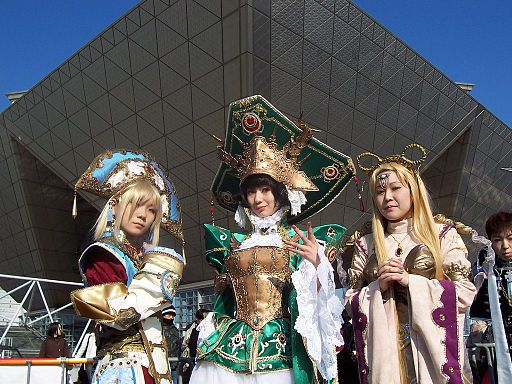[dt_button link=»http://d165vjqq8ey7jy.cloudfront.net/mp3/20504/se-8082s.mp3″ target_blank=»true» button_alignment=»default» animation=»fadeIn» size=»small» style=»default» bg_color_style=»custom» bg_color=»#333333″ bg_hover_color_style=»custom» bg_hover_color=»#444444″ text_color_style=»custom» text_color=»#ffffff» text_hover_color_style=»custom» text_hover_color=»#dddddd» icon=»fa fa-cloud-download» icon_align=»left»]Скачать[/dt_button]
[dt_divider style=»thin» /]
Transcript:
Voice 1
Welcome to Spotlight. I’m Robin Basselin.
Voice 2
And I’m Ryan Geertsma. Spotlight uses a special English method of broadcasting. It is easier for people to understand no matter where in the world they live.
Voice 1
It is the middle of July. Jamie is standing outside of a large building. She is in San Diego, California, in the United States. It is warm outside. But Jamie is wearing a lot of clothing. She is dressed in a man’s shirt, dress coat, trousers and neck tie. Over the top of this, she is wearing a long, brown coat. And on her feet are sport shoes. These clothes would look very unusual on a woman in most any place. But in San Diego in July, no one seems to think it is strange. In fact, all around Jamie, there are many other people dressed in strange, unusual clothing.
Voice 2
Jamie and the people around her are dressed unusually because they are cosplayers. A cosplayer — or costume player — is someone who wears clothing to look like their favorite character from a film, television show, or book. Jamie is dressed as The Tenth Doctor from the British television program, Doctor Who. And she is at one of the largest gatherings of cosplayers in the world — San Diego Comic Con. Cosplayers like Jamie wear costumes to have fun. And they join together to enjoy a different cultural experience. Today’s Spotlight is on “cosplay.”
Voice 1
It is not unusual to be a fan of a television program, film or story. Fans are people who really enjoy particular stories, characters or even performers. Often, they like to see pictures of and read news stories about them. And many people even want to look or be like their favorite television, film or story characters.
Voice 2
Cosplay is an extreme way of showing that a person is a fan of something. For example, a fan of the Japanese television program Sailor Moon might dress like the program’s main character. She might wear shoes that go up to her knees and a long fake hair wig.
Voice 1
Allison is a cosplayer from Georgia in the United States. She does a kind of cosplay called “crossplay.” Crossplay is when a person acts like a character who is a different sex. A woman may cosplay as a man, or a man may cosplay as a woman. Allison told The Guardian news organization:
Voice 3
“It is very satisfying when you play your part so well that people do not recognize that you are a crossplayer until you speak.”
Voice 2
Many large fan groups have conventions or gatherings. At these conferences, fans meet together. They discuss elements of the program they enjoy with other fans. And they also meet the people who create the programs. These conventions also provide a chance for people to do cosplay with other fans.
Voice 1
Courtney Stoker is a writer. She wrote a story about fan conferences and cosplay for The Guardian news organization. She explains,
Voice 4
“Cosplayers are a huge part of these conventions. They show people the costumes they make. They have their pictures taken. And they act like the characters. The reasons for doing cosplay are different for different people, but there is one common element. Cosplay offers a very public way to react to the published artwork and the fan community at the same time.”
Voice 2
One of the most famous cosplay conventions is San Diego Comic Con. In July of every year, thousands of fans, television and film stars, and writers travel to attend this gathering. However, the world’s largest cosplay event is called Comiket. It happens twice a year in Tokyo, Japan. And people from all over the world travel to attend.
Voice 1
Cosplay is probably most popular in the country of Japan. It gained popularity at conventions for animated television programs and films. Animation is when drawn images are put together to produce what looks like one continuous moving image. In Japan, these kinds of animated stories are called “anime.” And “Anime” is very popular. Over time, many cosplayers began to attend these anime conferences. They would dress and act like their favorite characters.
Voice 2
In Japan, cosplayers are often more serious about cosplaying than in other places like the United States. Often, Japanese cosplayers will not talk about who they really are. They will always act like the character they are playing. The costumes are also very important. They are often made at home, and are very carefully designed. Costumes can cost nearly 1,000 United States dollars.
Voice 1
Although cosplay is popular in Japan, it is not accepted by everyone in the culture. Cosplayers in Japan are careful to keep their real names a secret. This is because many people in Japan think that cosplay is child’s play. They do not think cosplay is worth a player’s time and effort.
Voice 2
The Cosplay Research Project is a website all about cosplay. It contains many stories about the experiences of cosplayers. It also has a lot of research about the history and cultural effects of cosplay. In the section about cosplay in Japan, it says:
Voice 5
“It is not that the Japanese people are not proud of their hard work, their costumes and designs. It is just that most of Japanese society — their parents, and even some of their friends — may not like cosplay. This can sometimes lead to becoming an ‘ijime’- a person who is socially exiled or treated badly for doing cosplay.”
Voice 1
In Japan, the clothing a person wears is important. People often judge another person’s character by what they wear. This is an issue in many cultures. So, cosplay is appealing to many people because it gives them a chance to escape social pressures about clothing and social or economic class.
Voice 2
People also like cosplay because it can help them move past social barriers. For example, in many cultures, women have very defined social roles. Often, they are not able to share their thoughts and feelings on particular issues. But when a person cosplays, they can express their opinions in a safe way. They feel like they can say things they may not say if they were dressed normally.
Voice 1
Cosplay is also a way for people from all different cultures to connect. People from around the world can become friends with other people who share their interest in particular stories and characters. And they can share in a common cosplay culture.
Voice 2
Although many people may think cosplay is a little strange, it can have many positive results. As Courtney Stoker writes,
Voice 4
“Cosplay offers a space for fans to enjoy, criticize, and discuss their opinions about what they love. And sometimes they can do it all with the same costume.”
Voice 1
The writer and producer of this program was Dianna Anderson. The voices you heard were from the United States. All quotes were adapted for this program and voiced by Spotlight. You can listen to this program again, and read it, on the internet at www.radioenglish.net. This program is called, “Cosplay: Playing Your Favorite Character.”
Voice 2
We hope you can join us again for the next Spotlight program. Goodbye.




